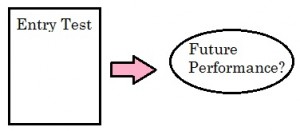Design of Experiments > Criterion Validity
What is Criterion Validity?

Criterion validity (or criterion-related validity) measures how well one measure predicts an outcome for another measure. A test has this type of validity if it is useful for predicting performance or behavior in another situation (past, present, or future). For example:
- A job applicant takes a performance test during the interview process. If this test accurately predicts how well the employee will perform on the job, the test is said to have criterion validity.
- A graduate student takes the GRE. The GRE has been shown as an effective tool (i.e. it has criterion validity) for predicting how well a student will perform in graduate studies.
The first measure (in the above examples, the job performance test and the GRE) is sometimes called the predictor variable or the estimator. The second measure is called the criterion variable as long as the measure is known to be a valid tool for predicting outcomes.
One major problem with criterion validity, especially when used in the social sciences, is that relevant criterion variables can be hard to come by.
Types of Criterion Validity
The three types are:
- Predictive Validity: if the test accurately predicts what it is supposed to predict. For example, the SAT exhibits predictive validity for performance in college. It can also refer to when scores from the predictor measure are taken first and then the criterion data is collected later.
- Concurrent Validity: when the predictor and criterion data are collected at the same time. It can also refer to when a test replaces another test (i.e. because it’s cheaper). For example, a written driver’s test replaces an in-person test with an instructor.
- Postdictive validity: if the test is a valid measure of something that happened before. For example, does a test for adult memories of childhood events work?
References
Beyer, W. H. CRC Standard Mathematical Tables, 31st ed. Boca Raton, FL: CRC Press, pp. 536 and 571, 2002.
Dodge, Y. (2008). The Concise Encyclopedia of Statistics. Springer.
Vogt, W.P. (2005). Dictionary of Statistics & Methodology: A Nontechnical Guide for the Social Sciences. SAGE.
Wheelan, C. (2014). Naked Statistics. W. W. Norton & Company